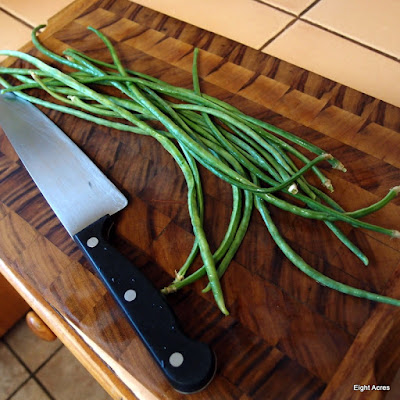One of the really fun things about our
sub-tropical climate is the weird veges that we can grow. I've written about a few them before (
rosella, warrigal greens and sweet potato), and other posts about
chokos and
trombonchino. Here's one more that I like to grow: the snake bean.
Vigna unguiculata subsp. sesquipedalis also known as yardlong bean,long-podded cowpea, asparagus bean, pea bean, or Chinese long bean. You might have guessed from that, it is a LONG bean, up to 30cm in my experience. Apparently
sequipedalis means "one and a half feet", so it must get even longer in some conditions. It is a different genus to the common bean and more closely related to cow peas and mung beans.
Snake beans grow on vines and seem to prefer hot and wet weather, but will tolerate dry better than common beans, and will certainly produce better in the heat. Like common beans, they do not survive frost and start to die back when overnight temperatures cool off. The plant produces two flowers off each stem and these grow into beans, sometimes it seems like its overnight, but they can be hard to spot because at first they just look like stems and then suddenly you realise the vine is covered in beans! They are also really hard to photograph, as you can see. Any that get too big can be left to dry off, and used either as dried beans or seeds.
 |
| the snake bean vine |
 |
| two beans starting, can you see them? |
 |
| the snake been flower |
 |
| I left this one too long, still good for seeds |
I think they taste best when they are small, and they taste is similar to common beans. In our climate its good to grow a few snake beans with the common beans and then depending on how summer goes, one will do better, and the common beans will keep going even when the weather cools off in autumn.
Apparently you can also eat the leaves, but I've never be short on other greens to want to try it.
Do you grow snake beans? Do you grow any other weird vegetables?






I grow them in Virginia, US where it is hot and humid. I like them because a lot of the insects that ravage the regular bush and pole beans do not eat these. They grow on poles but not as much growth as regular pole beans. The hard thing is catching the long beans before they get too ripe as they blend in with the vines so well but as you have found, they produce seed for next year. I think they taste best stir fried with a little soy sauce and garlic. They are a good choice and may produce when there is a crop failure with regular beans.
ReplyDeleteI don't know if they would grow in our Mediterranean climate here in Sth Aust Liz, but I used to buy them from the bazaar when I lived in Nepal. Fried in ghee and served with our daal and rice, delicious!
ReplyDelete